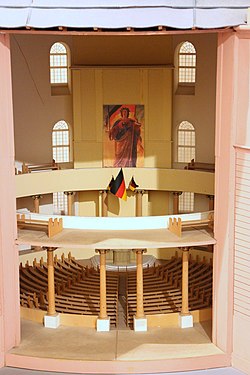
Philipp Veit was a German Romantic painter and one of the main exponents of the Nazarene movement. It is to Veit that the credit of having been the first to revive the nearly forgotten technique of fresco painting is due.

The Germanisches Nationalmuseum is a museum in Nuremberg, Germany. Founded in 1852, it houses a large collection of items relating to German culture and art extending from prehistoric times through to the present day. The museum is Germany's largest museum of cultural history. Out of its total holding of some 1.3 million objects, approximately 25,000 are exhibited.

The Way of Human Rights is a monumental outdoor sculpture in Nuremberg, Germany. It was opened on 24 October 1993. It is sited on the street between the new and old buildings of the Germanisches Nationalmuseum, connecting Kornmarkt street and the medieval city wall.

Johannes Praetorius or Johann Richter was a Bohemian German mathematician and astronomer.

Nuremberg Funnel is a jocular description of a mechanical way of learning and teaching. On the one hand, it evokes the image of a student learning his lessons with this kind of teaching method almost without effort and on the other hand, a teacher teaching everything to even the "stupidest" pupil. It can also reference forceful teaching of someone's ideas, ideology, etc.

Mark Lammert, is a German painter, illustrator, graphic artist and stage designer. He lives and works in Berlin.

Nuremberg Charterhouse was a Carthusian monastery, or charterhouse, in Nuremberg in Germany. Its surviving premises are now incorporated into the Germanisches Nationalmuseum.

Elke Rehder is a German artist living in Barsbüttel Germany.

Katerina Lemmel, OSsS was a successful German patrician businesswoman in Nuremberg who became a Bridgettines nun at the monastery of Maria Mai in Maihingen in Nördlinger Ries. A collection of letters that she wrote from the monastery to her relatives in Nuremberg permits multifaceted insights into life in a late-medieval female monastery and into its system of spiritual economies.

Peter Angermann is a German painter based in Nuremberg.

Christ among the Doctors is an oil painting by Albrecht Dürer, dating to 1506, now in the Museo Thyssen-Bornemisza, Madrid, Spain. The work belongs to the time of Dürer's sojourn in Italy, and was according to its inscription executed incidentally in five days while he was working on the Feast of the Rosary altarpiece in Venice. The work was influenced by Leonardo da Vinci and possibly based on the most probably earlier painting by Cima da Conegliano on the same theme.

Hans Philipp Werner, Freiherr von und zu Aufseß (1801–1872) was a German baron, antiquarian and lead founder of the Germanisches Museum in Nuremberg.
Horst Wolfgang Böhme is a German archaeologist with a focus on Late Antiquity / Early Middle Ages and research into castles.

The Ardennes Cross is a wooden processional cross from the Carolingian period, said to originate in a monastery in the Luxembourg Ardennes. Since 1894 it has been in the Germanisches Nationalmuseum, in Nuremberg.

Germania is a painting created by Philipp Veit in 1834-1836. Germania in general is a female personification of Germany. This painting is one of two side pictures of the big mural painting Introduction of the Arts to Germany by Christianity. The other side picture presents Italia. The fresco transferred to canvas measures 285 by 192 cm and is exhibited in the Städelsches Kunstinstitut in Frankfurt am Main.
Ottogerd Ludwig Wilhelm Mühlmann was a German academic, art historian, notable for his work in historical preservation.

Gerd-Helge Vogel is a German art historian.
Georg Ulrich Großmann is a German art historian. He was general director of the Germanisches Nationalmuseum in Nuremberg.

Daniel Preissler was a German painter, originating from Bohemia.
Rolf Fritz was a German art historian. His research focused on German art from the Middle Ages to the 19th century, especially on the art and cultural history of Westphalia, as well as on various genres of arts and crafts.





















